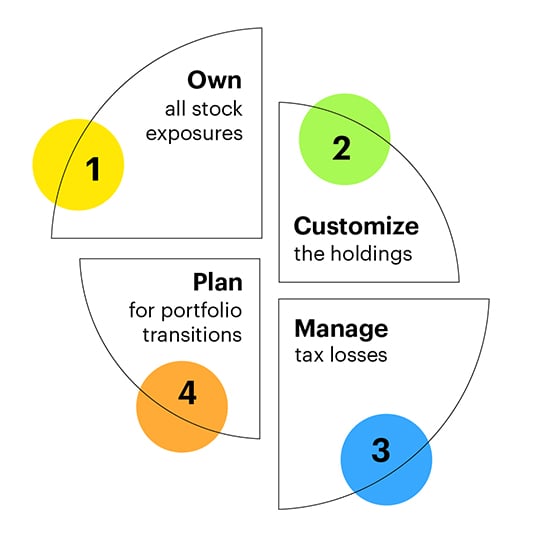Capabilities
Direct Indexing With Allspring
Unlocking SMArt possibilities with custom SMA portfolios for personalized, tax-smart strategies.

Own the stocks you want. We’ll work to keep the tax bill in check.
Direct indexing gives you personalized ownership of individual stocks through a representative subset of securities designed to mirror an index — all within a single account.
It can offer powerful advantages: you can customize your portfolio to reflect your values and financial goals, while tapping into tax management through ongoing tax-loss harvesting — helping you offset gains and potentially reduce your tax liability.

As an investor, you’ve likely purchased an index fund or ETF before. Direct indexing is different—it's index investing, made personal. Watch the video or you can read more in our Direct Indexing FAQ.
Transcript
Manju Boraiah: Remember when we all had to buy entire CDs just to get one song we wanted? Today you can create your own playlist, skip the songs you don't like, repeat your favorites, and still discover new music. Now, imagine having the same flexibility when you're designing your own portfolios for investing—being able to create your own personalized investment playlist. We believe direct indexing offers a compelling solution for investors seeking to meet their own needs and goals. So, what is direct indexing? Direct indexing is an investment strategy that allows investors to directly own the individual securities that make up an index—just like the S&P 500—rather than having to invest in a fund that tracks an index. Because of its customization features, it offers more control and flexibility than traditional index investing. Now, here's how it works. Direct indexing portfolios are managed in a separately managed account, or an SMA, which contains a portfolio of individual stocks that mirror an index. But here's the difference—unlike a fund that seeks to track an index, a direct indexing portfolio can be customized to reflect you or your client’s preferences. For instance, maybe you prefer to exclude a particular company's stock within the portfolio or exclude an entire industry of stocks. With direct indexing, these and a wide range of other portfolio adjustments are made possible. But here's where direct indexing can get even more interesting. Because investors actually own the individual securities within their portfolio, they can benefit from additional capabilities like ongoing tax management, portfolio transparency, and transition planning. First, let's start with the tax benefits. Direct indexing portfolios offer robust tax management capabilities. Capturing losses to offset gains for tax-loss harvesting purposes can take place continually and systematically at the individual security level. Now, here's an example of harvesting losses on a single stock. Let's say Stock A has a value of $50,000. Over time, Stock A loses value and is now only worth $40,000. Stock A can then be sold at a loss and replaced with Stock B with a similar risk profile. The captured losses can then be used to offset gains of other stocks in the portfolio, potentially resulting in tax savings and enhanced performance. Now, consider the possibilities at scale. Tax-loss harvesting at the individual security level can offer opportunities to exploit volatility and generate tax alpha throughout the life of a portfolio, even in up-markets. This helps investors tap into a highly robust, year-round tax management program designed to help them keep more of what they earn. Next up, transparency. Direct indexing investors also have the benefit of high visibility into their portfolio holdings, helping them better understand how their money is being managed and providing the ability to make informed investment decisions. Finally, how about transition planning? Direct indexing can help ease portfolio transitions through detailed tax mitigation. Instead of selling entire positions, investors can manage individual holdings, reduce tax impact, and use harvested losses to offset gains—making the shift to a new strategy a more tax friendly experience. Now that we understand the benefits of direct indexing, let's talk about who can benefit the most. Thanks to advancements in trading technology and lower fees, direct indexing has become a much more viable and accessible strategy for many investors. Now, do any of these describe you or your clients? An investor seeking to maximize after-tax returns? Or those with large taxable accounts where tax-loss harvesting matters the most? What about investors seeking to align portfolios with faith-based values? Or those looking for control over specific securities held in their portfolios? And finally, how about owners of concentrated stock positions looking to mitigate concentration risk? Does that sound familiar? Then, consider how direct indexing can empower you and your clients to take control of investments with customization, tax efficiency, and transparency. At Allspring, direct indexing is all about choice—shaping your financial future in a way that's right for you. It's index investing, made personal.
Who is direct indexing right for?
Direct indexing at Allspring




Tax management and estate planning
A key ingredient of direct indexing is to optimize tax management for each client’s situation.
Meet Holly Swan, Allspring’s expert on tax-aware investing. You can read Holly’s tips on taxes in her “Income Insights” and “Swan Songs” series on Allspring’s web page for tax management and estate planning.

Direct indexing offerings
With Allspring’s direct indexing, you have options
Remi: Unlocking SMArt possibilities through personalized, tax-smart direct indexing strategies with Allspring Global Investments.

Our facts and figures
A partner for personalized direct indexing
$77B+
(billion)
in total SMA assets under advisement
Top 10
Allspring ranking
for the largest independent¶ SMA providers in the industry by assets*
3rd
Third largest
provider of model-delivery SMA provider in the industry by assets*
50
SMA offerings
that are distinct strategies on the Allspring investment platform
Important information
Featured insights
Remi is a solution for personalizing separately managed account portfolios, powered by technology, research and human insights. Remi's portfolio construction engine, backed by our fundamental research team, simplified transitions and tax management. Remi is a service of Allspring Funds Management, LLC offered indirectly to investors through financial intermediaries. Investors should contact their financial advisor for more information.
Allspring Global Investments does not provide accounting, legal, or tax advice or investment recommendations. Any tax or legal information in this document is merely a summary of our understanding and interpretations of some of the current income tax regulations and is not exhaustive. Investors should consult their tax advisor or legal counsel for advice and information concerning their particular situation.
An investment strategy that considers environmental, social and governance (ESG) characteristics in the selection of investments may perform differently than a strategy without such an emphasis, or the market as a whole. The investment strategy may forgo investments or make investments that differ from an otherwise similar investment strategy that does not evaluate and select investments on the basis of their sustainability or ESG credentials. ESG information utilized by the Investment Manager to assess the sustainability or ESG characteristics of issuers received from third-party data providers may be incomplete, inaccurate or unavailable. As a result, there is a risk that the Investment Manager may incorrectly assess a security or issuer.
Allspring Managed Account Services (the firm) is a unit within Allspring Global Investments and is responsible for the management and administration of the Allspring Funds Management, LLC, retail separately managed account portfolios (wrap portfolios). Allspring Funds Management acts as a discretionary manager for separately managed accounts ("SMA") and as a non-discretionary model provider in a variety of managed account or wrap fee programs (“MA Programs”) sponsored by third party investment advisers, broker-dealers, or other financial services firms (a “Sponsor”). When acting as non-discretionary model provider, Allspring Funds Management responsibility is limited to providing non-discretionary investment recommendations (in the form of model portfolios) to the Sponsor. The Sponsor may use these recommendations in connection with its management of MA Program accounts. In these “model-based” programs, the Sponsor serves as the investment manager and maintains trade implementation responsibility.
Tax-loss harvesting is the selling of investments at a loss so that losses can be used to offset gains on the sale of other investments—thereby reducing capital gains tax owed. Proceeds from the sale may be used to purchase similar securities to maintain the general composition of the investment portfolio.
The investment strategies described herein are those of Allspring Managed Account Services. These materials are being provided for illustrative and informational purposes only. No assurances can be given that any strategy or objective will be achieved. Separately managed account strategies may not be suitable or appropriate for all investors. The information contained herein is obtained from multiple sources that are believed to be reliable. However, such information has not been verified and may be different from the information included in documents and materials created by the sponsor firm in whose investment program a client participates. Some sponsor firms may require that these Allspring Managed Account Services materials be preceded or accompanied by investment profiles or other documents or materials prepared by such sponsor firms, which will be provided upon a client’s request. For additional information, documents, and/or materials, please speak to your financial advisor.
INVESTMENT RISKS: All investments contain risk. Your capital may be at risk. The value, price, or income of investments or financial instruments can fall as well as rise and is not guaranteed. You may not get back the amount originally invested. Past performance is not a guarantee or reliable indicator of future results.





